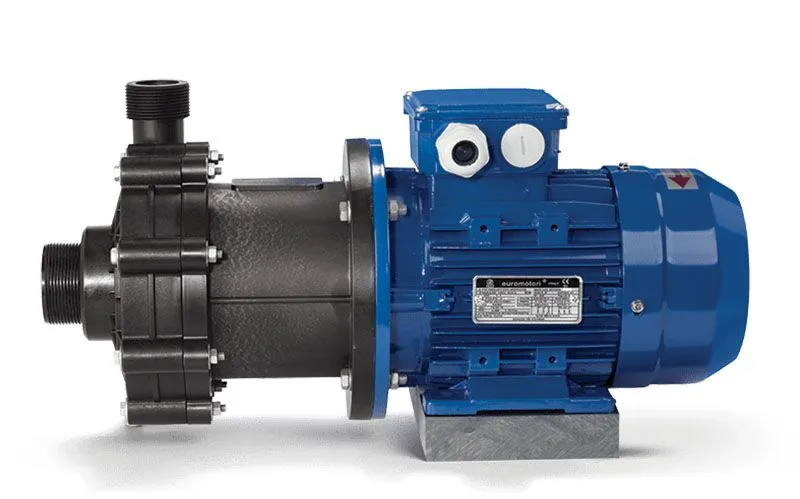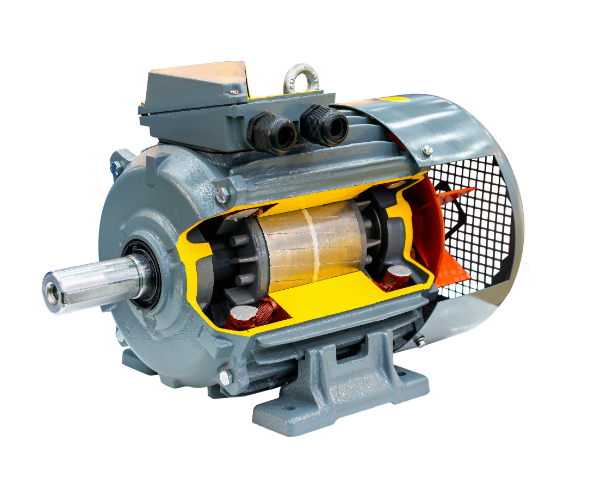The maintenance of the three-phase motor involves routine checks for wiring to be secure, balanced three-phase voltage within ±5% to avoid overheating. The bearings should be lubricated with appropriate grease every 4000 hours and checked for vibration at less than 2.5 mm/s. Windings’ insulation resistance should be tested; its value has to be above 1 MΩ to prevent winding short circuits. Clean dust from the surface regularly, and also clean the motor ventilation openings for efficient heat dissipation. Compressed air should be used.
Check Wiring
Since a three-phase motor can only carry out its functions through the wiring system, periodic checks must be carried out. Therefore, for a high load in a three-phase motor and increased exposure to harsh environments in industrial areas, the risk of wiring issues will be higher. Firstly, check that all points in the wiring connections are tightened to their rated torque. Local overheating due to the increase in contact resistance can occur due to loose wiring; thereby leading to damage to the motor or a fire hazard.
Check the balance with the digital multimeter or oscilloscope: three-phase voltage deviation within ±5%, should unbalanced voltage occur, there would be local overheating in windings, degradation in insulation performance, and thus burning of windings is possible. Furthermore, in the case of an operation under a variable frequency drive, observe the harmonic distortion of the input voltage since excessive harmonic content—for instance, total harmonic distortion exceeding 8%—accelerates motor heating and thus shortens its service life.
Regarding the junction box, pay attention to the insulation sleeves on the terminals for discoloration, damage, or scorch marks. Take protection to shut off dust and liquid, in particular for chemical plants or humid areas, by using protection level IP55 or above. Check the gaskets of the boxes, verify that they are not aged or deformed; replace them if necessary to preserve protection. For safety reasons, all the following checks must be made with the power off. Use appropriate electrical tools and wear personal protective equipment.
Inspect Bearings
The bearings of the three-phase motors are critical mechanical elements that support the rotor and reduce friction in order to make the running of the motor smooth. The condition of the bearings reflects the reliability of the motor. In case of a failure, the bearing reduces efficiency and causes severe mechanical damage. Thus, the regular examination of bearings becomes one of the central activities in the maintenance of motors.
There are various techniques for the evaluation of the condition of bearings: vibration analysis, temperature monitoring, and lubricant sampling. When normal, the vibration frequency for bearings is supposed to be within a range of 1-10 kHz. Using a high-precision vibration analyzer, observe the vibration velocity and acceleration at some frequency peaks. The speed of the vibration should be less than 2.5 mm/s RMS for healthy bearings. If its value is higher, it indicates some problem with wear, deformation, or failure of lubricant.
The other main method for bearing health assessment is temperature monitoring. Measure the temperature of the bearing outer ring either with an infrared thermometer or with a thermal imaging device. The temperature that a bearing should attain in normal conditions shall not be greater than 70°C. In case the temperature rises beyond 80°C, immediate investigation shall be carried out about the causes that can be poor lubrication, overloading, or high ambient temperature. Through lubricant sampling analysis, the lubricant can be checked for contaminants like metal particles or moisture to know the state of wear of the bearing.
Whenever a problem in the bearing is identified, act immediately by lubrication, replacing, or by re-aligning the motor shaft. During installation or replacement of bearings, specialized tools should be employed that will help in evenly distributing pressure and thus offers protection against failure of bearings at an early stage due to improper installation. The selection or choice of bearing or lubrication should be appropriately chosen; under high-temperature conditions, grease that will resist high temperature should be applied for lubrication.

Test Insulation
The insulation characteristics of motor windings are very important in regard to motor life and safe operation; therefore, insulation resistance tests are one of the basic maintenance tests. The insulation performance may be lowered by deterioration, absorption of moisture, or operational overload and cause a short circuit or damage in windings. During visual inspection of the motor, insulation resistance is to be measured using a megohmmeter, especially after a long standstill period or when operated under humid conditions.
The insulation resistance tests should only be performed when the motor is off and at ambient temperature. Connect the megohmmeter probes at the terminals of the winding of the motor and to ground, testing between windings and windings to ground. In general, insulation resistance above 1 MΩ is required. If the insulation resistance is less than the minimum threshold, insulation performance is degraded, calling for further investigations or repairs. In high-power motors, an insulation resistance above 10 MΩ has a higher safety factor.
Improve the insulation with other protection methods like varnishing anti-moisture insulation varnish onto the windings or use heaters to dry out the motor. Where the humidity in the area is above 70%, an automatic heating device fitted on a motor will ensure the temperature of the winding is higher than the ambient temperature to avoid harm to the insulation from condensation. Also, for variable frequency drive applications, note the switching frequency and cable routing to avoid insulation damages due to high-frequency currents.
Lubricate Parts
Proper lubrication prolongs the service life of the bearing and ensures smooth operation of the motor. Insufficient lubrication would increase friction, raise temperature, and may even cause seizure of the bearing. The frequency and type of lubrication shall be determined according to the operating environment, load conditions, and runtime. Generally speaking, lubrication for motors under normal conditions should be done every 4000-5000 hours. Shorten this to 2000-3000 hours in high-load or high-temperature conditions.
The type of lubricant to be used is selected based on the recommendation of the motor manufacturer. The lithium-based grease is quite commonly used because of its excellent oxidation resistance at high temperatures. Care should be taken when applying grease so that a specified amount will be applied, avoiding under- or over-lubrication. Too little lubrication leads to the early wear of bearings while too much grease causes overheating or the extrusion of grease. The application of grease shall be done at a slow rate until it begins coming out of the drain hole.
The bearing temperature should be monitored after lubrication to determine whether the distribution of grease inside the bearing is uniform or not. If the temperature keeps rising, then the quality of the grease and alignment in the motor shaft should be inspected. Alignment of the motor shaft and the parallelism of the bearing seat must meet the manufacturer’s specification in order to reduce friction and abrasion. Due to the different varieties in motors, particular attention should be paid to the type of motor during lubricant selection and lubrication scheduling by referencing the motor technical manual.
Clean Motor
Regular cleaning of the motor prevents dust and debris from gathering on the heat sinks and ventilation openings, thus allowing good heat dissipation. This is particularly important at factories, mines, or construction sites where dust and particulates seriously lower the capability of cooling the motor, raising temperatures, insulation aging, and thermal faults. Utilize low-pressure compressed air to blow away the dust with care so as not to force it into the windings or bearings.
If there is any indication of oil or chemical residue on the surface of the motor, then it is necessary to use industrial-grade cleaners. It is also important to note that such cleaners must be pure and free from moisture and corrosive factors. After the cleaning process, the casing of the motor is to be dried out. Check for any possible destruction and deformation of protective covers and heat sinks. In case the humidity level of the environment is comparatively high, it would be a good idea to check regularly if the protective covers of the motor are well sealed in order to avoid moisture from getting inside.
Check the motor fan and fan cover for any damage. Replace all damaged parts in order to maintain good airflow. The fan cover should be securely fixed to avoid any vibrations and operation noise. Keep the heat sinks clean and without blockage to ensure good cooling efficiency and prevent motor overheating.

Monitor Vibration
Vibration monitoring represents one of the most important methods for ensuring motor maintenance. It helps to detect mechanical defects such as bearing failure, misalignment, or rotor imbalance in their initial phase. Thereafter, the vibration signals are recorded either by portable vibration meters or online monitoring systems for further analysis. The main indicators which present vibrations include velocity, acceleration, and displacement. Normally, a motor’s vibration velocity should be less than 2.5 mm/s RMS. If the value exceeds this, an immediate check must be performed.
The study of the vibration spectra is done to detect the source of vibration. Generally, low-frequency vibration arises due to rotor imbalance, while high-frequency vibration may occur from a faulty bearing. Frequency analysis tools provide the exact point of fault, which may give maintenance data in detail. If abnormal vibration is detected, the motor alignment, coupling, foundation bolts, and load condition must be checked for proper coordination.
Provide permanent online monitoring systems that issue early warnings for critical equipment to prevent unexpected failures. Perform calibration of monitoring systems periodically to ensure accurate data. Combine vibration monitoring with other diagnostic techniques, like thermal imaging and ultrasonic testing, for a comprehensive predictive maintenance strategy to improve motor reliability and prolong its life.
Run Load Tests
Load testing confirms that the motor works stably under real conditions, detects performance defects, and evaluates efficiency and power output. During a load test operation, maintain the rated load operating range. Overloading or too low loading affects performance and may cause mechanical damage. It is stated under the IEC standard that the motor load current should fall within ±10% of rated current; adjust parameters when deviations are seen.
Measure the voltage, current, power factor, and real power with a three-phase power analyzer. Low power factors less than 0.9 decrease motor efficiency. Look for load imbalances and the condition of power factor correction devices. For variable frequency drives, take output and carrier frequency to minimize thermal and electrical stresses on the motor.
Load testing ensures good matching of the motor with the load equipment to avoid prolonged operation beyond the peak efficiency zone. It enhances technical data analysis on the load testing of the equipment, thereby supporting managers in optimizing processes and reducing energy consumption. In the large industrial sector, data from load tests assist in motor selection and energy-saving projects for economic and reliable operations.








